Quality of the Environment in Japan 1992
(5) Vinna Convention and Montreal Protocol
The "Vienna Convention For the Protection of the Ozone Layer" was adopted in March l985 on the basis of UNEP studies and entered into force in September 1988.
And the "Montreal Protocol on Substances that deplete the Ozone Layer" which provides for concrete measures to control ozone depleting substances in accordance with the Convcntion, was adopted in Septem-ber 1987 and enterd into force in January 1989. As for Japan, the Convention entered into force in December 1988 and the Protocol entered into force in January 1989.
At the Second Meeting of the Parties to the Montreal Protocol held in June 1990, the adjustments was adopted such as the total phase out of CFCs and Halons by the year 2000, and Amendment, such as total phase out of, 1,1,1-trichloroethane (methyl chloroform) by the year 2005, and establishment of Multilateral Fund for aid to developing countries.
12-3 Bilateral Cooperation Under Conventions
(1) Activities Based on U. S.-Japan Environmental Protection Cooperation Agreement
The ministerial-level Joint Planning and Coordination Committee has held meetings since the agreement was reached in 1975. In 1989, the ninth meeting was held in Washington, D. C. Cooperation is being steppel up in 15 projects.
(2) Activities Under U. S.-Japan Cooperative Program in Natural Resources (UJNR)
The 13th p1enary session of the U. S.-Japan Conference on the Development and Utilization of Natural Resources established in 1964 was held in Tokyo in May 1991. The specialists' groups on conservation, recreation and parks have held 16 meetings. In fiscal 1991, interpreta-tion specialists. were sent to strengthen relations in October.
(3) Activities Based on U. S.-Japan Scientific and Technical Agreement
A new U. S.-Japan scientific and technical cooperation agreement was concluded in June 1988. In Appendix 1 to this agreement, seven major fields of cooperation are addressed, including earth science and the global environment. On the basis of this agreement, 50 projects were agreed on at the 1991 meeting and joint studies were begun.
(4) Activities Based on Japanese-German Scientific and Technical Agreement
A panel on technology for environmental protection under the Japanese-German Technical Cooperation Agreement concluded in 1974 was held in Tokyo in 1991 to exchange views on five themes on coopera-tion.
(5) Activities Based on Scientific and Technical Cooperation Agreements with Other Countries
As part of the Project on the Quality of the Urban Environment (Amenities) based on the Japanese-French Scientific and Technical Cooperation Agreement, the 7th Japanese-French Amenity Conference held from October to November in 1991.
(6) Activities Based on Migratory Bird Protection Conventions
On the basis of the japanese-Australian Migratory Bird Protec-tion Agreement and the Japanese-Chinese Migratory Bird Protection Agreement, the 6th Consultation on the Management of the Japanese-Australian Migratory Bird Protection Agreement was held in October 1991 and the 5th Conference on the Japanese Chinese Migratory Bird Protection Agreement was held in October 1991 and the 5th Conference on the Japanese-Chinese Migratory Bird Protection Agreement in November 1991.
12-4 Environmental Cooperation with Developing Countries
In developing countries, forests and other vegetation decrease or their quality degenerates due to population pressure and poverty. In this conjunction, they are confronted with soil erosion, the depletion of water sources, ongoing desertification, the destruction of natural resources, such as depletion of wildlife, and the degrading quality of natural resources, among others. Also due to the increase and concentra-tion of population, especially in urban areas, problems are arising up on the living environment. Environmental pollution and nature disruption of the sort which has surpassed the Japanese experiences are observed due to rapid industrialization and other factors. While they are confront-ed with those conventional environmental issues, there has arisen the need to cope with environmental issues common to the entire earth, such as the depletion of the ozone layer and global warming. As there is a shortage of funds and other resources, it has become important for developed countries to extend support to them. It is also important to give support to central and eastern European countries where environ-mental measures have been neglected in the past.
Given those circumstances, requests for cooperation from Japan are rapidly rising. In response, Japan agreed to strengthen its support at the Council of Ministers for Global Environment Conservation. While taking advantage of its experiences, Japan is strengthening cooperation in the environmental sector, particularly for technical cooperation. As a result, Japan had accomplished over a short span of two years before 1990 its commitment to replenish official development assistance in the environmental sector with the pledge, made at the Arches Summit in 1989, to offer Y300 billion or so over period of three years beginning in 1989. As indicated in Fig. 12-4-1, the dispatch of specialists in the environmental sector has rapidly increased.
Furthermore, related ministries and agencies are trying to develop a system in which environmental factors will be taken into consideration in offering cooperation in the environmental sector and in extending development aid.
On the other hand, in preparing for the Earth Summit, developing countries have demanded greater support from the developed world, arguing that the transfer of funds in the environmental sector from the developed world to the developing world be new and additional, and preferential.
Fig. 12-4-1 Trends in the dispatch of specialists in the environmental sector (recommended by Environment Agency)
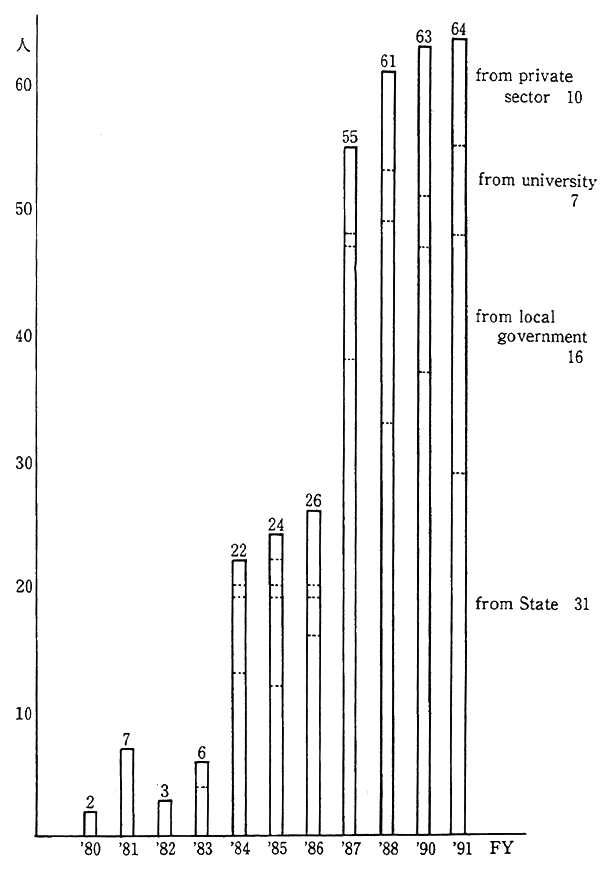
Incidentally, international cooperation in the environmental sec-tor is being similarly reinforced by the nongovernmental sector, includ-ing businesses and private organizations.
In order to contribute to the evolution of new environmental policy measures with the momentum of the Earth Summit, the Director-General of the Environment Agency requested advice from the Central Council for Environmental Pollution Control and the Natural Environ-ment Conservation Council on the "Way Environmental Policy Ought To Be in an Era of Globalization" in December 1991. As they are poised to deliberate a broad range of items, the councils are scheduled to draw conclusions before the Earth Summit on the further promotion of inter-national cooperation in the environmental sector and of environmental considerations.
In fiscal 1991, environmental cooperation was rendered to devel-oping countries in the following manner:
12-4-1 Official Development Assistance
(1) Surveys and Exploration of Projects
In order to understand the conditions of developing countries and the social and economic conditions which formed the background, strengthen a wide variety of policy dialogues with developing countries and probe for excellent aid cases, a survey team for the selection and confirmation of projects in China was dispatched in July 1991 and another survey team for the formation of projects in China in November 1991 to positively perform a wide variety of surveys.
(2) Development Surveys
For the formulation of public development programs in develop-ing countries, the followingsurveys were performed in fiscal 1991:
a. Study on Air Pollution Control Plan in Bogota City (Colombia)
With a view to studying the existing state of air pollution and formulating pollution control programs in the city of Bogota, technical cooperation has been rendered since July 1990. In November 1991, a survey team was dispatched for briefings on the draft of a report, consultations and a technology transfer seminar.
b. Air Quality Management Study for Kelang Valley Region in Malaysia
As regards development surveys designed to cast light on the air quality in Kelang Valley near Kuala Lumpur and formulating an air pollution prevention and control program, a survey team was dispatched in December 1991 to start technical cooperation.
c. Study on Water Pollution Control Plan for Lake Poyang in China
With a view to preventing the water pollution of Lake Poyang, the largest of all freshwater lakes in China, which is blessed with a rich natural environment and formulating optimum environmental pollution measures, technical cooperation started in February 1992.
d. Study on Recuperation of the Guanabara Bay Ecosystem in Brazil
With a view to understanding the conditions of water pollution and its mechanisms in Baia de Guanabara facing Rio de Janeiro and in the basins of the rivers flowing into the bay and formulating comprehen-sive pollution prevention measures, an advance survey team was dispat-ched in October 1991.
e. Study on Coastal Resources Inventory Management and Development
With a view to conserving and utilizing natural ecosystems, to sustainablely utilizing their fishery and other resources and to working out regional development models centering on small-scale fisheries, an advance survey team was dispatched in December 1991.
f. Programs for Treatment and Recycling Industrial Waste Water in the Republic of Korea
In order to survey methods to treat industrial waste water from industrial parks and the present situation of recycling in relation to two lines of business--gilding and dyeing--and formulating measures for improvements, a survey team was dispatched in February 1992.
g. Plans for Measures to Cope with Stationary Sources of Air Pollution in Mexico
With a view to formulating plans for coping with air pollution for which factories and other stationary sources were responsible, develop-ment surveys have been under way since August 1989, and a survey team was dispatched in January 1992 for briefings on the draft of a report and consultation.
h. Plans for Coping with Mine Pollution in Mexico
In order to carry out fact-finding surveys on mine pollution at three of Mexico's major dressing plants and formulate plans for coping with it, development surveys have been under way since August 199 l.A survey team was dispatched in January 1992 for briefings on thedraft of a report and consultation.
i. Plans for Coping with Industrial Pollution in Sfax (Tunisia)
A development survey will start in December 1990 to formulate programs for treatment of wastewater effluent and exhausted smoke and for recycling, on factories of phosphoric fertilizer production, tanning, olive oil and dyeing, which form the major industries of Sfax, Tunisia's second largest city and a prominent industrial city.
j. Desulfurization System for Kozienice (Poland) Power Plant
Development surveys have been under way since October 1990 in order to formulate an optimum program for the desulfurization of pollutants emitted from the Kozienice Power Plant, situated 75 kilo-meters south of Warsaw, and study a technical and economic feasibility, development surveys have been under way since October 1990. In November 1991, a survey team was dispatched for briefings on the draft of a report, consultations and the holding of a technology transfer seminar in November 1991.
k. Desulfurization System for Melnik (Czechoslovakia) Coal Power Plant
In order to make economic and technical feasibility studies on the desulfurization of smoke exhausted from Plants No. 2 and No. 3 of the Melnik Coal Power Plant, located 40 kilometers northwest of Prague, and formulate an optimum program, an advance survey team was sent in December 1991.
(3) Dispatch of Experts
The Japan International Cooperation Agency (JICA) dispatches Experts. In fiscal 1991, it sent 64 Experts to Thailand, China and other countries. The calls of developing countries for the dispatch of Experts in the environmental sector have rapidly increased in recent years, suggesting that the securing of skilled manpower is a serious question.
(4) Acceptance of Trainees
With the cooperation of related ministries and agencies and local governments, the Japan International Cooperation Agency (JICA) pro-vided group training in fiscal 1991. In fiscal 1991, group training was provided on environmental administration, environmental technology (air and water pollution) and so forth. Special nation-specific training is also provided to East European countries and Indonesia. In response to calls from developing countries, individual training is also provided in response to the needs of each country as occasion demands. (Table 12-4-1 and Table 12-4-2)
Table 12-4-2 Acceptance of Individual Trainee in the area of Environmental Conservation
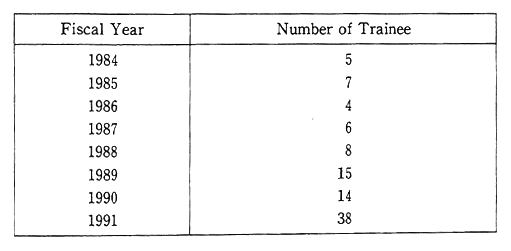
(5) Project-Type Technical Cooperation
In providing project-type technical cooperation for Environmen-tal Research and Training Center in Thailand, a long-term team of eight specialists was dispatched and nine Thai trainees were accepted
Table 12-4-1 Group Study Courses in the Area of Environmental Conservation
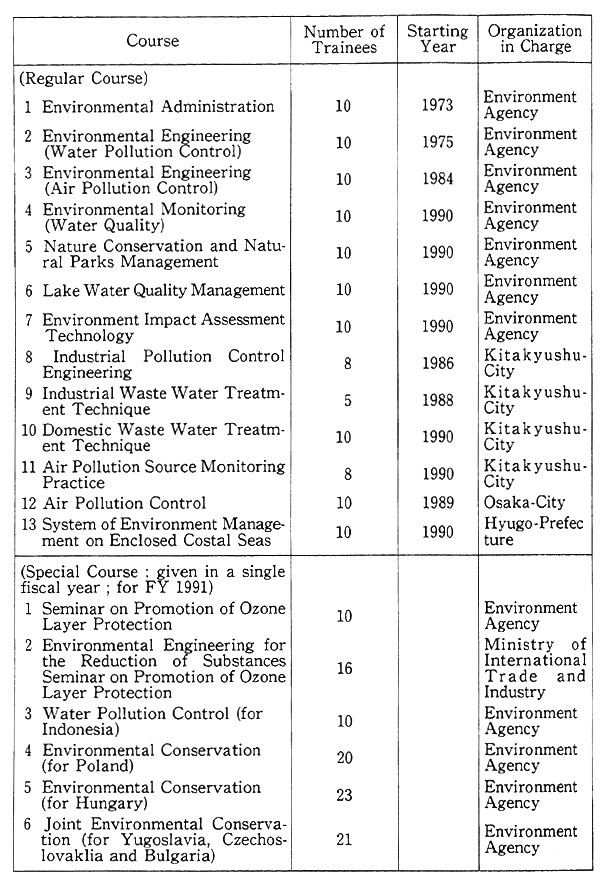
While project-type technical cooperation in technology for the prevention of mine pollution in Chile came to an end in October 1991, a long-term team of four specialists was dispatched to Brazil and four Brazilian trainees were accepted to cooperate with the Brazilian Mine Pollution Prevention Training Center.
In connection with similar environmental centers in China and Indonesia, preparations were made in fiscal 1991 for the offer of project-type technical cooperation which would start in fiscal 1992. Similar preparations were also made for the Water Pollution and Waste Water Recycling Research Center and the Energy-Saving Education Center in China.
(6) Roles of Local Governments, Etc.
Local governments and other organizations which have ample experience and skilled manpower in the environmental sector play an important role in rendering environmental cooperation. In fiscal 1991, local governments dispatched a total of 16 environmental experts.
(7) Grant Capital Assistance
a. Environmental Research and Training Center in Thailand
Japan is providing Grant Capital Assistance from fiscal 1991 to fiscal 1992 to the tune of Y 862 million in total in the establishment of the center which would integrally carry out research, training and monitoring in the environmental sector.
b. Sino-Japanese Friendship Environment Conservation Center
Grant Capital Assistance is provided in 1991 and 1992 to establish a center which will consist of environmental monitoring, information division, pollution abatement division and so on. Total cost of this assistance account for 10,256 billion yen.
c. Environmental Management Center in Indonesia
Japan provided grant capital assistance to the tune of ¥845 million in the establishment of a center which would carry out research on environmental policy, monitoring, training and the collection and offer of information.
(8) Loans
Loans are quite instrumental in cooperating with countries pos-sessing certain degrees of economic and technical power. Up to now, Japan has offered loans for Indonesia and other countries in the forest sector and for desulfurization systems for oil plants in Mexico and so forth. In fiscal 1991, the following projects were conducted:
a. Program for Expansion of Indonesian Environmental Research, Center
Japan pledged in September 1991 to advance ¥1.1 billion in loans in collaboration with the World Bank to develop educational and research facilities for the manpower training at the Indonesian Environ-ment Research Center established at a national university to conduct surveys and researches on environmental problems.
b. India's Aravalli Range Afforestation Projects
Japan pledged in December 1991 to advance ¥8.1 billion in loans for 115,000 hectares of afforestation in the Aravalli Range in the State of Rajasthan in India.
(9) Cooperation Through International Institutions
In fiscal 1991, Japan made a contribution to the United Nations Environment Programme (UNEP), the world's second largest contribu-tion after that of the United States, and contributed about $9,620,000 to the Yokohama City-based International Tropical Timber Organization (ITTO).Japan also stepped up cooperation with multilateral aid institu-tions in the environmental sector and contributed $3,750 million (includ-ing 7,320,000 SDR [$10 million] to the Core Fund of GEF to) the World Bank and the Asian Development Bank for environmental considera-tions. In addition, fund contributions are also made to the FAO, CGIAR and other international institutions concerning the promotion of envi-ronment conservation projects.
(10) Cooperation by Official Funds Other Than Official Development Assistance
For the project of removing lead content in gasoline, which was part of the comprehensive program to cope with Mexico's air pollution, the Japan Export-Import Bank concluded a contract for the offer of a total of up to ¥53.6 billion in loans in June 1991.
(11) Cooperation in the Gulf Crisis
After Iraq's invasion of Kuwait on August 2,1990--in particular, after Iraq spilled crude oil and fires broke out at oil fields in Kuwait, the Gulf area were directly confronted with grave environmental problems.
Japan provided Gulf nations with oil fences as an emergency measure. After the Gulf crisis was over, Japan dispatched an interna-tional emergency relief team through the Japan International Coopera-tion Agency (JICA) for the recovery of spilled oil. Besides, it sent specialists in the sectors of the conservation of seawater desalination facilities, air pollution, marine pollution and the protection of wildlife. Also in order to support international institutions on environmental issues, Japan contributed $1,11 million to the United Nations Environ-ment Program (UNEP) for the preparation of an emergency action program and $1.5 million to the Gulf oil pollution disaster fund of the International Maritime Organization (IMO) and dispatched experts. In addition, cooperation is rendered by private organizations.
(12) Environmental Cooperation with Eastern Europe
When it comes to grave environmental issues in Eastern Europe, Japan, acting in response to what Former Prime Minister Toshiki Kaifu expressed on his visit to Eastern Europe in January 1991, accepted trainees from East European countries. It also cooperated in coping with air pollution in the Miskloc area of Hungary, flue gas desulfuriza-tion at the Kozienice Thermal Power Plant in Poland and by the Melnik Thermal Power Plant in Czechoslovakia. Japan invested $800,000 in the Regional Environmental Center for Central & Eastern Europe estab-lished to support measures to cope with environmental issues in the East European region.
12-4-2 Roles of the Private Sector
(1) Roles of Businesses
Many of the environment conservation technologies, such as environmental pollution systems, have been developed by private corpo-rations. They are also playing a significant role in the transfer of technology, including direct investments in developing countries. At issue is how to promote the transfer of technology by the private sector.
(2) Roles of Private Organizations
Private organizations are participating in the promotion of inter-national environmental cooperation, such as the execution of environ-ment conservation projects, and their activities will accelerate more as the interest in global environment issues mounts. For example, interna-tional exchanges of skills and information with developing countries have become an important task for the Japan Committee on the Global Environment established as a lateral organization for each circle of Japanese society in fiscal 1991. The International Center for Environ-mental Technology Transfer, the International Lake Environment Committee, the Overseas Environmental Cooperation Center, the Orga-nization for Industrial Spiritual and Cultural Advancement Interna-tional (OISCA) and other bodies corporate for the public good, and the Japan International Volunteers' Center, the Buddhist Soto Sect Volun-teers' Society and other voluntary organizations carry out environmen-tal projects ranging from the government level to the grass-roots level and hold symposia, lecture meetings and seminars.
(3) Dept for Nature Swap
The Debt for Nature Swap (DNS) is a system in which nongover-nmental organizations (NGOs) purchase unrecoverable debts of develop-ing countries and, instead of demanding the repayment of the debts, call on the respective governments to implement nature protection mea-sures, such as the conservation of tropical forests, utilizing their own currency. The Environment Agency compiled a report on DNS and presented issues for Japan in June 1991.
As a concrete example, a corporation in the United States of the Bank of Tokyo concluded a DNS contract worth $1 million with the U. S. Committee of the Worldwide Fund for Nature(WWF-US) in July 1991. As another example, the Daiichi-Kangyo Bank donated $1 million in bonds to the Japan Committee of the Worldwide Fund for Nature (WWF-J) in March 1992, and it is decided to set aside this fund for a nature protection project of the Galapago Islands.
Moreover in October, it was decided to develop a nature protec-tion liability swapinformation center in the Overseas Environmental Cooperation Center (OECC).
12-4-3 Environmental Considerations in Official Development Assistance
(1) Environmental Considerations in Official Development Assistance
As agreed at the Related Ministers' Conference on Conservation of the Global Environment in 1989, the government make a point of strengthening environmental considerations in offering Official Develop-ment Assistance. The Japan International Cooperation Agency (JICA) formulated the Guideline on Environmental Impact Surveys for Dam Construction Programs in February 1990 and is formulating such pro-grams for other sectors, too. The Overseas Economic Cooperation Fund (OECF) which takes charge of yen loans is striving to assure environ-mental consideration according to the guideline it released in October 1989 on environmental considerations.
(2) Environmental Considerations in Overseas Corporate Ventures
As agreed on at the Council of Ministers for Global Environment Conservation in 1989, efforts are being made to see to it that environ-mental considerations are appropriately made.
In the Keidanren Charter on the Global Environment prepared by the Federation of Economic Organizations (Keidanren) of Japan, 10 items on environmental considerations, including compliance with the environmental quality standards of countries into which Japanese corpo-rations have made inroads, and private businesses are also striving to conserve the environment of the countries where they have established firms.
(3) Multilateral Consultations on Development Assistance
The OECD Development Aid Committee (DAC) made a recom-mendation, the items of which are listed below, on development aid and environment in October 1991:
a. Good practices for country environmental surveys and strategies
b. Good practices for environmental impact assessment of develop-ment projects
c. Guidelines for aid agencies on involuntary displacement and resettlement in development projects
d. Guidelines for aid agencies on global environmental problems
12-5 Overseas Public Information
"Quality of the Environment in Japan, 1989," "Environmental Research in Japan 1989" and other periodicals and "Action Program to Arrest Global Warming" were translated into English and published for distribution to governments, international institutions and various environment-related institutions, and public-information activities are positively conducted.
Chapter13. Surveys and Research on Environment protection
13-1 Research by National Institute for Environmental
13-1-1 Strengthening of Research System
The National Institute for Environmental Studies (NIES), estab-lished in 1974, was reorganized in July 1990, in order to incorporate the natural environment conservation to the domain of its research, and to reinforce research associated with both global and local environments. The Environmental Training Institute was merged into the National Institute for Environmental Studies as the Environmental Training Center.
In October 1990, the Center for Global Environment Research was established in the National Institute for Environmental Studies to support studies on the global environment and promote global environ-mental monitoring. In fiscal 1991, the Satellite Remote Sensing Research Team was established in the Global Environment Division.
As of the end of fiscal 1991, the institute was made up of two research groups, seven departments and three centers. The number of employees is 274.
13-1-2 Research Activities
(1) Research Work
In fiscal 1991, current researches were made on 134 subjects, special researches on 10 subjects and global environment researches with the Global Environment Research Program Budget on 42 subjects. The subjects of special researches made in fiscal 1991 are as follows:
(A) Study for a systematic evaluation of chemosphere under highly advanced technologies
(B) Comprehensive assessment and management of aquatic environ-ment based on the notion of carrying capacity
(C) Experimental studies on the health effects of air pollutants containing diesel exhaust
(D) A study to develop an environmental health system to monitor environmental stress and health effects in the metropolitan area
(E) Development of a comprehensive method of assessing the envi-ronmental deterioration caused by traffic systems
(F) Multiplier effects of chemical pollutants at ecosystem level in aquatic environments
(G) Studies on countermeasures against environmental pollution caused by the diversification of industrial structure and life-style
(H) Studies on aquatic ecosystem mechanism and environmental conservation in enclosed coastal seas
(I) Studies on application of biotechnology to preservation of the environment and on evaluation of its effects
(J) Characteristics of wetland ecosystems and their stability against environmental changes
(2) Work on Environmental Information
The Environmental Information Center replenished the database associated with the environmental quality, such as by the magnetic-tape editing and recording of various monitored data on Japan's environ-ment. It also works as focal points for foreign countries under the International Referral System for Sources for Environmental Informa-tion (INFOTERRA) of the U.N.Environment Programme (UNEP). The Center for Global Environment Research was designated as a center for the Global Resources Information Database (GRID) of UNEP, and streamlined its activities as GRID Tsukuba.
(3) Support to Global Environment Research
The Center for Global Environment Research acquired a super-computer in fiscal 1991. and strived to reinforce its research support system, including the holding of an information exchange and confer-ence of researchers on the global environment.
13-2 Surveys and Research on Environment Conservation
13-2-1 Surveys and Research at Present
Studies on environment protection are broadly promoted by the State, local governments and the nongovernmental sector at present.
In stepping up these studies, it is necessary for the State to work for close coordination among the related research institutions and researchers now that the related sectors of science and technology are broad and the research sectors are closely tied in with one another. For this reason, the Environment Agency appropriates in a lump sum the costs of researches and studies on the prevention of environmental pollution undertaken by the research and study institutions of the related ministries and agencies and others, and then allocates those funds for a comprehensive coordination of the surveys and researches which form the basis for promotion of national policy measures. In addition, the agency carries out surveys and research with the Coordina-tion Fund for Encouragement of Comprehensive Surveys and Research for Conservation of the Environment in order to efficiently take emer-gent actions.
In regard to the development of large-scale and comprehensive technologies, or those for which there are particularly significant admin-istrative needs, or that of drastically new technologies which would encourage non-pollution, efforts are made for their promotion by organ-izing large-scale projects with the involvement of the private sector or the formulation of subsidization measures to the private sector.
The environmental institutions of local governments carry out surveys and research which are closely tied in with the environmental administration of their respective areas, so that the Environment Agency continues to promote their activities.
13-2-2 Environmental Research and Studies by National Institutions
(1) Outline
The fund appropriated in a lump sum in the Environment Agency in fiscal 1991 for environmental research and studies by national institu-tions was ¥1,928,043,000 for 92 themes (¥1,928,043,000 for 93 themes in the preceding fiscal year), and those research and studies were conduct-ed by the 45 institutions which belonged to 13 ministries and agencies.
In respect of environmental research and studies with the fund, efforts have been continued to organize and promote comprehensive research projects in each research area with consideration given not only to immediate problems but to the formation of the basis for measures in along-term perspective.
(2) Compreprehensive Research Projects
In Fiscal 1991,9 comprehensive research projects were carried out as staed below:
a. Study on air pollution prevention
b. Study on the sophistication of effluent treatment
c. Study on marine lake and reservoir pollution prevention
d. Study on the treatment of wastes and recycling technology
e. Study on the management and conservation of the natural envi-ronment
f. Study on the development of planning methodologies for the conservation of the urban environment
g. Study on the prevention and assessment of noise and vibration
h. Study on the sophistication of monitoring technology on environ-mental pollutants
i. Study on the assessment of the effects of environmental pollut-ants
In addition the aforementioned 9 comprehensive research pro-jects, research was conducted on 2 themes in fiscal 1991, including the problems caused by nitrogenous pollutants in domestic water use and their control.
13-2-3 survey and Research with Budget for Promotion and Coordination of Comprehensive Surveys and Research for Environment Conservation
The main surveys and researches conducted with this budget in fiscal 1991 are follows: Environment Agency
* A survey on the impacts on the natural environment of such chemical fertilizers as ammonium sulfate used for prevention of melting snow at ski areas in national parks
* An emergency survey on measures for the protection of wild fauna by the extraordinary propagation of goats in the Ogas-awara Islands
* An emergency surveys on fauna and flora protection
* A survey for Establishment of Methodologies for surveillance of CFC concentrations in the atmosphere An emergency survey for support to the IPCC Ministry of International Trade and Industry
* A survey for response to international conferences on disrupting technology of specified CFCs Ministry of Transport
* A survey for response to international restrictions on ship exhaust Environment Agency and Forestry Agency
* An emergency survey on the impacts of the eruption of the Unzen Hugendake Volcano on the natural environment of the Unzen area of the Unzen-Amakusa National Park
13-2-4 Surveys and Research with Budget for Surveys and Research on Prevention of Environment Pollution
The Environment Agency is doing surveys and researches on particularly important issues for the promotion of environmental policy.
13-2-5 Other Research and Research Subsidization
The Ministry of International Trade and Industry, Ministry of Transport, Ministry of Construction and Ministry of Agriculture, For-estry and Fisheries are conducting research associated with their respec-tive administrative roles.
National universities are doing basic studies and training researchers in relation to environment conservation. With a subsidy for the budget for scientific research (priority study "Man and the Environ-ment--Changes and Controls") [105 subjects with ¥576,600,000 in grants-in-aid], basic and general studies on the environment were con-ducted.
13-2-6 Surveys and Research on Global Environment
The following surveys and research were conducted under Com-prehensive Promotion Program for Global Environment Research, Monitoring and Technology Development. (June 1991) and the Basic Plans for the Research and Development on Earth Science and Technol-ogy (August 1990), Etc.
(1) Promotion of Surveys and Researches
When it comes to problems on the global environment, the scale of subjects is greater than conventional environmental problems, the associated sectors are diversified and there remain many points which have yet to be clarified, such as mechanisms and impacts, so that there is the need to comprehensively promote surveys and research on the global environment. There is the need to take part in international programs related to the global environment, such as International Geosphere-Biosphere Program (IGBP) and World Climate Research Program (WCRP) and step up surveys and research. The main surveys and research conducted in fiscal 1991 are shown in Table 13-2-1.
Table 13-2-1 Research and Survey of Major Fields of Global Environment in FY 1991
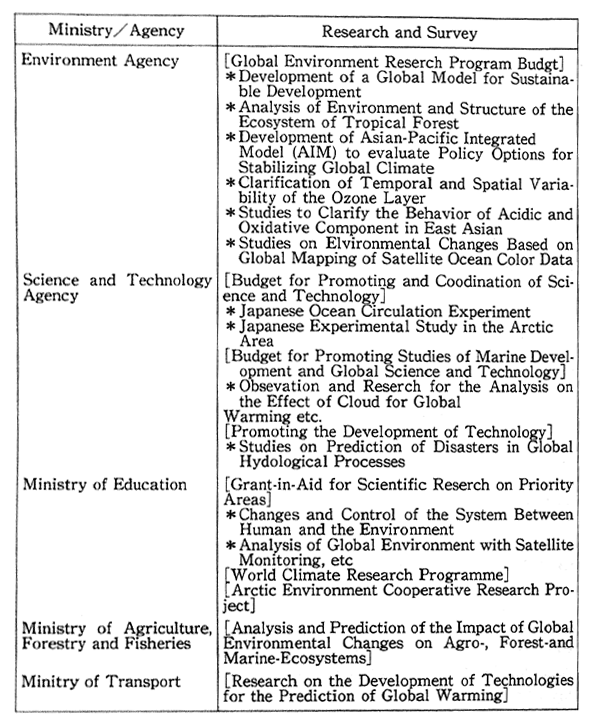
(2) Promotion of Technical Development
The development of main technologies made in fiscal 1991 are indicated in Table 13-2-2.
Table 13-2-2 Development of Technology in the Major Fields of Global Environment in FY 1991

13-2-7 Experiments and Research by Local Governments
The environmental experiment and research institutions of local gov-ernments play a role in supporting environmental administration by providing scientific information, actively promoting research on inher-ently regional problems.
The Environment Agency holds conferences of the directors of local environmental experiment and research institutions, and the meetings where researches on the environment conservation and the prevention of environmental pollution could meet and present their findings of the latest surveys and research, to step up exchanges of information among researchers.
The National Institute for Environmental Studies carried out joint research (55 subjects in fiscal 1991) with local environmental experiment and research institutions.
Chapter14. Other Environmental Administration
14-1 Upgrading Precision of Environmental Monitoring and Analysis
A survey on the condition of the precision of environmental monitoring and analysis was carried out. The substantial problems posed for the execution of environmental monitoring and analysis were also surveyed. This survey is so designed that uniformly adjusted environmental materials are forwarded to environmental monitoring and analysis institutions (more than 400) across the nation to survey relations among the findings of the analysis, previously processed conditions and conditions for the use of monitoring equipment, and other substantial problems for the execution.
In fiscal 1991, surveys were conducted on copper and nickel in sludge and five other items, and the pH electric conduction rate in the acid rain sample and nine other items are surveyed.
14-2 Training of Staff Officials in Charge of Environmental Administration
In order to step up environmental administration in an efficient manner, it is an important task to work for improvements in the attitude and ability of staff officials in charge of environmental adminis-tration in the State and local governments-
The Environment Agency established the Environmental Train-ing Institute in March 1973, and at the end of fiscal 1989, the total number of trainees had reached 18,752 (15,266 related to administration and 3,486 to analyses). In July 1990, the institute was merged into the National Institute for Environmental Studies as the Training Center for Environmental Affairs.
In fiscal 1991, improvements were made continuously in the contents of the training program, and administration related and analy-sis related training course was performed.
14-3 Health Measures, Etc. at Schools
The Ministry of Education carries out the following measures for the promotion of health measures:
a. Projects to promote the greening of the school environment
b. Projects for the promotion of nature classes
c. Construction work for the prevention of environmental pollution at schools
d. Loans for measures to cope with environmental pollution
e. Comprehensive projects for social and educational activities
14-4 Environment Conservation by Local Governments
Local governments take direct charge of control and guidance, the surveillance, monitoring and control of environmental pollution and so forth in accordance with laws and ordinances related to environment conservation. They also play a significant role in various projects against environmental pollution and nature protection.
Local environment conservation measures are implemented com-prehensively in response to the needs of local residents, while taking account of the local natural features, environmental conditions and socioeconomic trends. Many prefectures and administrative ordinance-designated cities participate in the formulation of local environmental control programs which will promote local environment conservation measures in a planned and systematic manner and also in the develop-ment of an environmental information system.
14-4-1 Organizations and Staff Officials in Charge of Environmental Administration
The situation of organizations and staff officials in charge of environmental administration in prefectures, administrative ordinance-designated cities and municipalities as of October 1, 1991, is as follows:
(A) Prefectures and Administrative Ordinance-Designated Cities
The situation of organizations and staff officials in charge of environmental administration is indicated in Table 14-4-1. The situation of staff officials in charge of nature protection is shown in Table 14-4-2.
(B) Municipalities
Table 14-4-1 Full-time and Concurrent Staff Officials in Prefectures and Administrative Ordinance-Designated Cities by Organization in Charge of Environmental Pollution
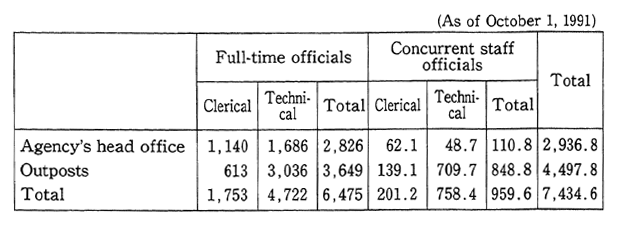
Remarks:1. Surveyed by the Environment Agency.
2. The figures for concurrent staff officials are those for which the number of staff officials who are also in charge of another line of administrative work is proportionally distributed, depending on the volume of their work.
3. The number of staff officials who deal with wastes and sewer systems are excluded.
Table 14-4-2 Full-time and Concurrent Staff Officials in Prefectures and Administrative Ordinance-Designated Cities by Organization in Charge of Nature Protection
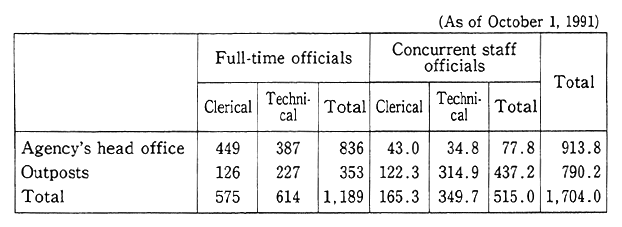
Remarks:1. Surveyed by the Environment Agency.
2. The figures for concurrent staff officials are those for which the number of staff officials who are in charge of another line of adminis-trative work is proportionally distributed, depending on the volume of their work.
The situation of organizations in charge of environmental admin-istration is as follows:
Municipalities having a bureau and a division (office) taking exclusive charge of environmental pollution 177
Municipalities having a subdivision (team) taking exclusive charge of environmental pollution 450
Municipalities having only staff officials taking exclusive charge of environmental pollution 253
Total 27.2% of all municipalities
Municipalities having outreach institutions 51 The situation of staff officials taking exclusive charge of environ-mental pollution is indicated in Table 14-4-3.
Table 14-4-3 Number of Staff Officials in Charge of Environmental Pollution in Municipalities (Full-time)
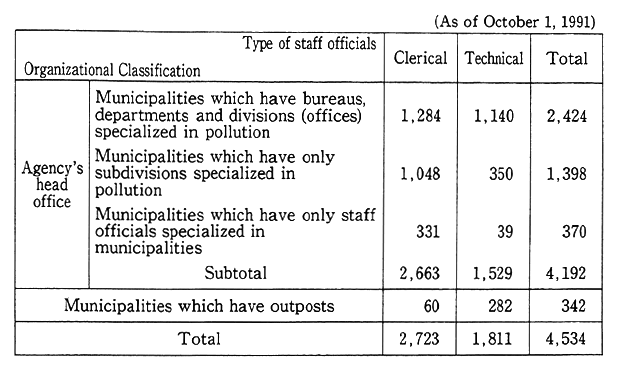
Remarks:1. Surveyed by the Environment Agency.
2. The number of staff officials in charge of wastes and sewer systems is excluded.
14-4-2 Enactment of Decrees
Local governments' decrees related to environment conservation are instrumental in comprehensively promoting substantial local envi-ronment conservation measures. They may be classified into four areas (1) decrees for the pollution prevention decrees on, (2) decrees forenvir-onment conservation, (3) conservation of the natural environment, and (4) other decrees forenvironment conservation (including decrees on environmental impact assessments). The enactmentof those decrees is as follows:
Decrees Related to Environment Conservation (Prefectures and Administrative Ordinance-Designated Cities)
(A) Decrees for the prevention of environmental pollution 54 organizations
(B) Decrees for Environment Conservation 9
(C) Decrees for Conservation of Natural Environment 47
(Nature Protection)
Other decrees related to environment conservation includes decrees on environmental impact assessments, decrees on natural parks, decrees on measures to cope with studded tires, decrees for prevention of lake and reservoir eutrophication, decrees for controls on the uptake of groundwater, decrees for greening, decrees for prevention of the dispersion of empty cans
Decrees related to environment conservation enacted by munici-palities as indicated in Table 14-4-4.
Table 14-4-4 Enactment of Ordinance Associated with Environment Conservation in Municipalities

Remarks : Surveyed by the Environment Agency.
14-4-3 Conclusion of Environmental Pollution Prevention Agreements
The following may be cited as reasons for the conclusion of agreements on the prevention of environmental pollution.
(A) It is possible to take elaborate environmental pollution preven-tion measures in response to geographical and social conditions.
(B) Businesses are aware that in locating a factory it is essential to secure the consent of local residents for their smooth corporate perfor-mance.
The conclusion of environmental pollution prevention agreements is as follows:
Environmental pollution prevention agreements concluded from October 1990 to September 1991 2,553
Environmental pollution prevention agreements valid as of September 30, 1991 37,000
Environmental pollution prevention agreements valid on golf links 1,200
The counterparts of the concluded agreements by line of business are shown in Table 14-4-5. By measure for the prevention of environ-mental pollution, they are indicated in Table 14-4-6.
The number of environmental pollution prevention agreements to which residents are parties or witnesses is indicated in Table 14-4-7.
Table 14-4-5 Number of Establishments Concluding Environmental Pollution Prevention Agreements by Line of Business
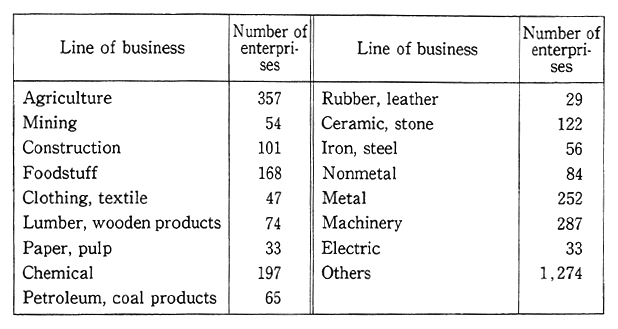
Remarks; 1. Surveyed by the Environment Agency.
2. The table represents a tabulation of agreements reached from October 1,1990, to September 30, 1991.
Table 14-5-6 Contents of Pollution Prevention Agreements

Remarks:1. Surveyed by the Environment Agency.
2. The table represents a tabulation of agreements concluded from October 1,1990, to September 20, 1991.
Table 14-5-7 Citizens' Participation in Pollution Prevention Agreements

Remarks:1. Surveyed by the Environment Agency.
2. The table represents a tabulation of agreements concluded from October 1,1990, to September 30, 1991.
14-4-4 Subsidization of Installation of Environmental Pollution Prevention Facilities
The actual amount at loans provided by local governmental environmental pollution facilities are shown in Table 14-4-8, and the subsidization of environmental pollution facilities by local governments is indicated in Table 14-4-9.
Table 14-5-8 Loan Program of Local Government for Pollution Control Investment (FY 1991)

Remarks: Surveyed by the Environment Agency Prefectural Government includes 11 big cities and municipalities include 23 wards in Tokyo.
Table 14-5-9 Subsidy Program of Local Government for Pollution Control Investment (FY 1991)

Remarks : Surveyed by the Environment Agency Prefectural Government includes 11 big cities and municipalities include 23 wards in Tokyo.
14-4-5 Outlays for Environmental Pollution Measures
The outlays made by local governments (including those by local government-managed businesses) are shown in Table 14-4-10.
Table 14-4-10 Settled Accounts for Municipal Pollution Measures (FY 1991)
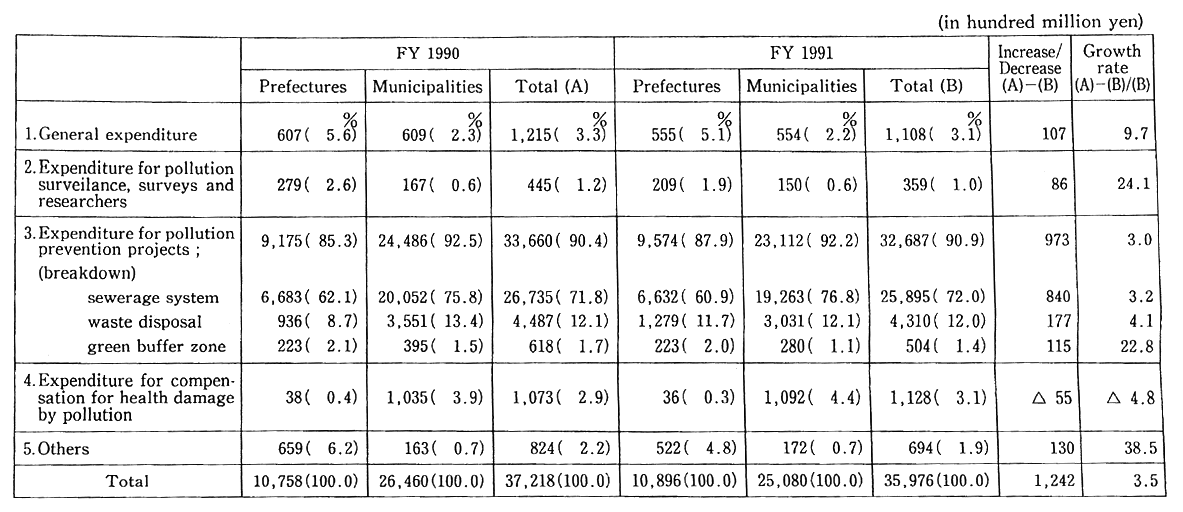
Remarks:1. Surveyed by the Environment Agency.
2. The settled accounts are those for which duplications between prefectures and municipalities arededucted.
14-5 Environmental Pollution Prevention Systems in the Private Sector
14-5-1 Enforcement of Environmental Pollution Prevention and Control Systems by the Private Sector
In accordance with the Law Concerning the Development of Organizations for Environmental Pollution Prevention at Specified Factories, factories were obligated in 1972 to assign environmental pollution prevention controllers , environmental pollution prevention managers, etc., and attempts are being made to develop environmental pollution prevention organizations at about 20,000 specified factories.
The assignment of environmental pollution prevention controllers (as of the end March 1991) is as follows:
Environmental pollution prevention About 23,000 persons
controllers (including proxies)
Environmental pollution prevention About 39,000
managers (including proxies)
Persons qualified for control of About 409,916
environmental pollution
(1) National Examination of Environmental Pollution Prevention Controllers
A national examination of environmental pollution prevention managers has been carried out each year since 1971, and the number of applicants in fiscal 1991 was 22,741. The number of actual examinees was 18,352, out of whom 4,283 persons successfully passed the examina-tion. The number of successful examinees prior to fiscal 1991 was 225, 350.
(2) Lectures for Certification of Qualifications
The number of persons who had completed lectures for the certification of qualifications before fiscal 1991 was 184,556.
14-5-2 Improvement of Environmental Monitoring in the Private Sector
Environmental pollution-related monitoring equipment is inspect-ed by designated inspection institutions.
A system of environment monitors was established in 1974. As of the end of December 1991, the number of registered monitors was 6,30l.
14-5-3 Establishment of Standards for Monitoring Methods
The Ministry of International Trade and Industry is striving to develop and expand Japan Industrial Standards (JIS) on standard gas and standard liquids.